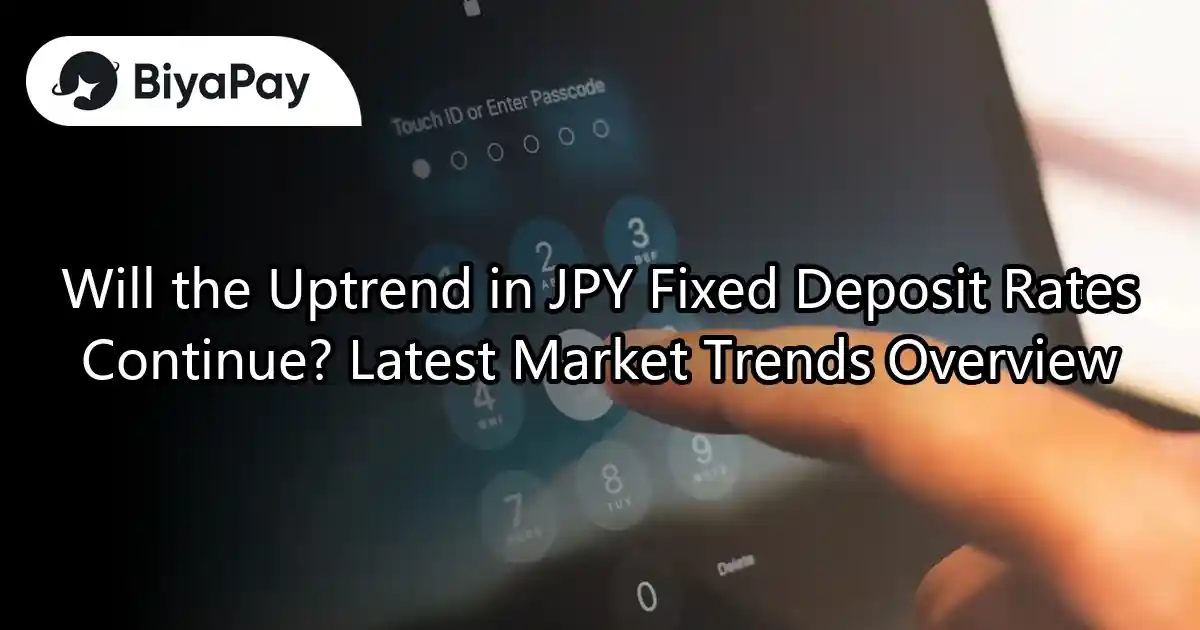- EasyCard
- Trade
- Help
- Announcement
- Academy
- SWIFT Code
- Iban Number
- Referral
- Customer Service
- Blog
- Creator
Will the Uptrend in JPY Fixed Deposit Rates Continue? Latest Market Trends Overview

Image Source: unsplash
In 2025, the market has observed a sustained rise in JPY fixed deposit rates. Policy adjustments by the Bank of Japan, inflationary pressures, international economic fluctuations, and market fund flows all have significant impacts on rate changes. Investors are closely monitoring the latest rates from major Hong Kong banks, deposit promotions, USD/JPY exchange rate fluctuations, and actively seeking suitable investment strategies to respond to market changes.
Key Points
- In 2025, JPY fixed deposit rates have generally risen, with many Hong Kong banks offering rates from approximately 1.20% to 1.35%, and some high-interest promotional products reaching 1.50%.
- The Bank of Japan continues to raise interest rates, ending years of low-rate policies, driving up deposit rates and attracting more funds into JPY fixed deposit products.
- The strengthening of the JPY exchange rate is closely tied to rising interest rates; investors should monitor USD/JPY exchange rate changes to avoid losses from fluctuations.
- Investors should carefully select bank products, noting minimum deposit amounts, deposit terms, and early withdrawal penalties, while diversifying investments to reduce risks.
- Continuously monitoring Bank of Japan policies and international economic trends, and flexibly adjusting asset allocation, can help seize market opportunities and ensure asset safety.
Rate Status

Image Source: pexels
Latest Data
In 2025, several major Hong Kong banks have launched different JPY fixed deposit rates. Nanyang Commercial Bank currently offers a one-year JPY fixed deposit with an annual rate of about 1.35%, Citibank offers 1.30%, and China Construction Bank Asia provides 1.28%. Some banks periodically launch high-interest promotional products with annual rates reaching 1.50% or higher. However, these high-interest products typically have minimum deposit requirements or are limited to new funds, and investors need to carefully review the relevant terms.
Experts suggest that investors should compare rates and promotions from different banks when choosing JPY fixed deposit products and pay attention to details such as deposit terms and early withdrawal penalties.
Recent Changes
Compared to 2024, JPY fixed deposit rates in 2025 have generally risen. In 2024, most banks offered one-year rates ranging from about 0.80% to 1.00%. In 2025, rates have increased to above 1.20%, reflecting growing market demand for JPY assets. Fund flows into JPY fixed deposit products are evident, and some banks have raised rates to attract new customers in response to market competition.
- 2024: One-year JPY fixed deposit rates were about 0.80% to 1.00%.
- 2025: One-year JPY fixed deposit rates have generally risen to 1.20% to 1.35%, with high-interest promotional products reaching 1.50%.
This upward trend is primarily driven by Bank of Japan policy adjustments and international fund flows. Investors should closely monitor the latest rates and promotional activities from banks and flexibly adjust their fund allocation.
Influencing Factors
Central Bank Policy
Since 2024, the Bank of Japan has gradually adjusted its monetary policy, ending an eight-year era of negative interest rates. On July 31, 2024, the policy rate was raised from 0–0.1% to 0.25%, while also reducing the scale of government bond purchases. On January 24, 2025, the short-term policy rate was further raised to 0.5%, marking a 17-year high. These measures prompted Japan’s three major banks—Mitsubishi UFJ, Sumitomo Mitsui, and Mizuho—to raise ordinary deposit rates from 0.1% to 0.2%. Small and medium-sized banks and regional banks have followed suit, gradually adapting the financial market to a rising rate environment.
Bank of Japan officials noted that while rising mortgage rates pose pressure on some households, since Japanese household deposits far exceed loans overall, rate hikes generally benefit depositors. JPY fixed deposit products have thus benefited, attracting more fund inflows.
| Item | Data and Notes |
|---|---|
| Policy Rate Adjustment | On January 24, 2025, the short-term policy rate rose to 0.5%, the highest in 17 years. |
| Deposit Rates of Major Banks | Ordinary deposit rates rose from 0.1% to 0.2%, approximately 40% of the policy rate. |
| Other Banks’ Responses | Regional and smaller banks have also adjusted deposit rates, reflecting market adaptation to the rising rate environment. |
| Historical Context | Negative interest rates were implemented starting in 2016, with the zero-rate era officially ending in March 2024. |
| Long-Term Impact | Regional banks, with a high proportion of long-term loans, improve performance more slowly, but the overall market is gradually adapting to the rising rate trend. |
Inflation and Economy
Japan’s economic data remains robust. In the third quarter of fiscal year 2025, GDP annualized quarterly growth reached 2.8%, far exceeding market expectations of 1.1%. Core CPI rose 3.2% year-on-year, hitting a high not seen since June 2023. Inflation has consistently exceeded the Bank of Japan’s 2% target, prompting the central bank to maintain a tightening policy.
The international economic environment also affects JPY fixed deposit rates. The U.S. economic recovery has strengthened the USD, leading to fund flows between USD and JPY. U.S.-Japan trade negotiations, tariff policy uncertainties, and geopolitical risks may drive safe-haven demand, further influencing the attractiveness of JPY assets.
Exchange Rate Trends
The JPY/USD exchange rate broke above 150 at the close on February 20, 2025, indicating JPY strengthening. The market expects the Bank of Japan to raise rates again in July 2025, further boosting JPY appreciation. Rate hikes typically drive deposit rate increases, attracting funds into JPY fixed deposit products.
Historical data shows a positive correlation between the JPY exchange rate and fixed deposit rates. When Japan’s economic data is strong and the central bank raises rates, the JPY exchange rate rises, deposit rates increase concurrently, attracting more investor attention to JPY assets.
Market Trends

Image Source: pexels
JPY Fixed Deposit Demand
In the first half of 2025, JPY fixed deposit rates have generally increased. Many Hong Kong banks have raised one-year JPY fixed deposit rates to 1.20% to 1.35%, with some promotional products reaching 1.50%. This upward trend has attracted significant fund inflows into JPY fixed deposit products. Investors aim to capitalize on the dual benefits of Bank of Japan rate hikes and JPY appreciation, shifting funds from USD or HKD to JPY fixed deposits. Banking industry insiders note that new fund inflows into JPY fixed deposits have grown by over 30% year-on-year. Some banks, in response to market demand, have shortened application periods for high-interest promotional products and raised minimum deposit requirements (e.g., starting from USD 10,000) to control funding costs.
Investors generally believe that JPY fixed deposit products remain attractive in the short term, supported by both interest rates and exchange rates. However, experts caution that the rate uptrend may not persist long-term, and fund allocation needs to remain flexible.
Expert Predictions
Several international financial institutions and analysts have offered varying predictions on future JPY trends and rate changes:
- Macquarie Group lowered its 2025 year-end JPY target from 142 to 135, expecting the JPY to soon break 140.
- Standard Chartered Bank estimates the JPY will break 140 by year-end and 136 in Q1 2025.
- Analysts generally believe that narrowing U.S.-Japan interest rate differentials is the primary driver of JPY appreciation. If the U.S. Federal Reserve (Fed) begins rate cuts, JPY appreciation potential will expand.
- Macquarie strategists note that Fed Chairman Powell’s hints at rate cuts during the Jackson Hole meeting spurred JPY appreciation.
- Some strategists, like Bank of America’s Shusuke Yamada, argue that Fed rate cuts may not necessarily lead to JPY appreciation, predicting the JPY could weaken to the 150–155 range by year-end.
- Nomura Asset Management’s team points out that JPY trends are influenced not only by Bank of Japan policies but also by the U.S. rate-cutting process. The larger the rate cut, the higher the likelihood of JPY appreciation.
- Japanese large corporations forecast JPY exchange rates between 140 and 145, and if the JPY does not break this range, corporate profits will not be harmed by exchange rate losses.
- UBS analysts predict USD/JPY will fall to 145 by the end of 2025, further dropping to 142 in Q1 2026, reflecting confidence in medium-term JPY strength.
- During heightened global safe-haven sentiment, the JPY may rebound temporarily, but rapid appreciation could impact Japan’s export competitiveness, potentially prompting verbal intervention by the Bank of Japan.
Experts generally agree that the attractiveness of JPY fixed deposit products is closely tied to U.S.-Japan interest rate differentials, Fed policies, and Bank of Japan actions. Investors need to closely monitor international rate and exchange rate changes and adjust asset allocation flexibly.
Risk Factors
While JPY fixed deposit products have performed strongly recently, investors should remain aware of several potential risks:
- High-interest promotional products often come with strict terms, including minimum deposit amounts, new fund requirements, and early withdrawal penalties. Some banks offer short-term application windows, and rates revert to standard levels after the promotional period.
- Exchange rate fluctuation risks are significant. If JPY appreciation falls short of expectations or the USD strengthens suddenly, investors may incur exchange losses when converting back to USD.
- Bank of Japan policy changes carry uncertainty. If rate hikes slow or the international economic environment deteriorates, JPY fixed deposit rates could decline.
- Global safe-haven sentiment changes rapidly. Geopolitical issues, trade negotiations, and sudden events could affect fund flows and JPY trends.
Experts recommend that investors carefully review terms when selecting JPY fixed deposit products, assess their risk tolerance, and diversify investments to avoid over-concentration in a single currency or product.
Investment Advice
Strategy Selection
Investors should choose suitable JPY fixed deposit products and deposit terms based on their risk tolerance. Common market strategies include conservative and balanced allocations. For example, some investors opt for Nomura Ireland-Japan Strategic Value Fund or Allianz AI Artificial Intelligence AT Accumulation JPY Hedged Fund, which adjust asset allocation based on JPY exchange rate trends. Balanced investors may consider Neuberger Berman Strategic Income Fund A Monthly Distribution JPY or BlackRock USD Non-Investment Grade Bond Hedged A6 JPY Stable Distribution Fund. These cases show that flexible strategy adjustments help navigate market fluctuations and enhance asset growth opportunities.
Experts suggest that investors first assess their liquidity needs before selecting deposit terms and product types to avoid overlooking liquidity risks in pursuit of high returns.
Risk Management
Effective risk management strategies can help investors minimize losses in varying market conditions. According to modern portfolio theory, diversification can eliminate non-systemic risks, enhancing the robustness of the overall portfolio. Over the past decade, Taiwan’s 0050 ETF and the U.S. S&P 500 Index’s annualized return and risk data demonstrate that diversified portfolios can maintain returns while reducing volatility. The book Essentials of Risk Management also illustrates the effectiveness of risk management strategies in practice through multiple corporate case studies. Investors should avoid concentrating all funds in a single JPY fixed deposit product and pay attention to details such as high-interest promotional terms, early withdrawal penalties, and minimum deposit amounts.
- Diversify investments across different currencies, products, and deposit terms
- Regularly review portfolios and adjust allocations based on market changes
- Carefully read product terms and assess personal risk tolerance
Continuous Monitoring
The market environment changes rapidly, and investors need to continuously track Bank of Japan policies, economic data, and international financial trends. Bank of Japan Governor Kazuo Ueda has repeatedly emphasized that the central bank will adjust policies based on the latest inflation and economic data. Investors can use economic indicator tools to regularly monitor data such as Japan’s core CPI, industrial output, unemployment rate, and USD/JPY exchange rate. Professional reports note that using momentum indicators and backtesting performance comparisons helps identify market turning points in real time and adjust investment strategies promptly. Recent volatility in stock and bond markets also demonstrates that continuous monitoring of market trends helps reduce losses and seize opportunities.
Investors should establish a habit of regularly reviewing portfolios and flexibly adjusting asset allocations based on the latest market information to ensure asset safety and growth.
In 2025, JPY fixed deposit rates continue to rise, with evident fund flows into JPY products. Investors should closely monitor Bank of Japan policies, interest rates, and USD/JPY exchange rate changes.
- Rationally analyze market information
- Carefully select Hong Kong banks’ JPY fixed deposit products
- Regularly review asset allocations
Experts suggest that investors adjust strategies based on the latest data to make informed decisions in volatile market conditions.
FAQ
How are JPY fixed deposit rates calculated?
Banks calculate interest based on the deposit amount, term, and prevailing annual rate. For example, USD 10,000 deposited for one year at a 1.3% rate yields approximately USD 130 in interest (excluding compounding and exchange rate fluctuations).
Is there a minimum deposit requirement for JPY fixed deposits?
Most Hong Kong banks set minimum deposit requirements, generally starting at USD 10,000 or higher. Some high-interest promotional products have higher requirements, and investors should check bank terms.
Do exchange rate fluctuations affect final returns?
Yes. If the JPY/USD exchange rate falls at maturity, converting back to USD may result in exchange losses. Investors should closely monitor exchange rate trends.
Are there penalties for early withdrawal of JPY fixed deposits?
Most banks impose early withdrawal penalties. Withdrawing early may result in the loss of some or all interest. Investors should choose appropriate deposit terms to avoid early withdrawals.
Who are JPY fixed deposits suitable for?
JPY fixed deposits are suitable for investors with moderate risk tolerance seeking stable returns and asset diversification. Experts recommend diversifying investments to avoid over-concentration in a single currency.
In 2025, rising Japanese yen fixed deposit rates and market volatility demand agile fund management. BiyaPay offers a secure, efficient solution to capitalize on JPY deposits and global market opportunities. No need for additional overseas accounts—BiyaPay enables trading in U.S. and Hong Kong stocks with a single account, plus a wealth management product with up to 5.48% annualized return, accessible anytime with flexible withdrawals. Start now at BiyaPay!
BiyaPay supports real-time conversions across multiple fiat and digital currencies with transparent rate queries, ensuring cost clarity. With remittance fees as low as 0.5%, it minimizes expenses. Regulated by international financial authorities, BiyaPay provides a robust platform to leverage JPY deposit trends while diversifying your portfolio. Visit BiyaPay today to maximize your wealth!
*This article is provided for general information purposes and does not constitute legal, tax or other professional advice from BiyaPay or its subsidiaries and its affiliates, and it is not intended as a substitute for obtaining advice from a financial advisor or any other professional.
We make no representations, warranties or warranties, express or implied, as to the accuracy, completeness or timeliness of the contents of this publication.




Contact Us
Company and Team
BiyaPay Products
Customer Services
is a broker-dealer registered with the U.S. Securities and Exchange Commission (SEC) (No.: 802-127417), member of the Financial Industry Regulatory Authority (FINRA) (CRD: 325027), member of the Securities Investor Protection Corporation (SIPC), and regulated by FINRA and SEC.
registered with the US Financial Crimes Enforcement Network (FinCEN), as a Money Services Business (MSB), registration number: 31000218637349, and regulated by FinCEN.
registered as Financial Service Provider (FSP number: FSP1007221) in New Zealand, and is a member of the Financial Dispute Resolution Scheme, a New Zealand independent dispute resolution service provider.



















